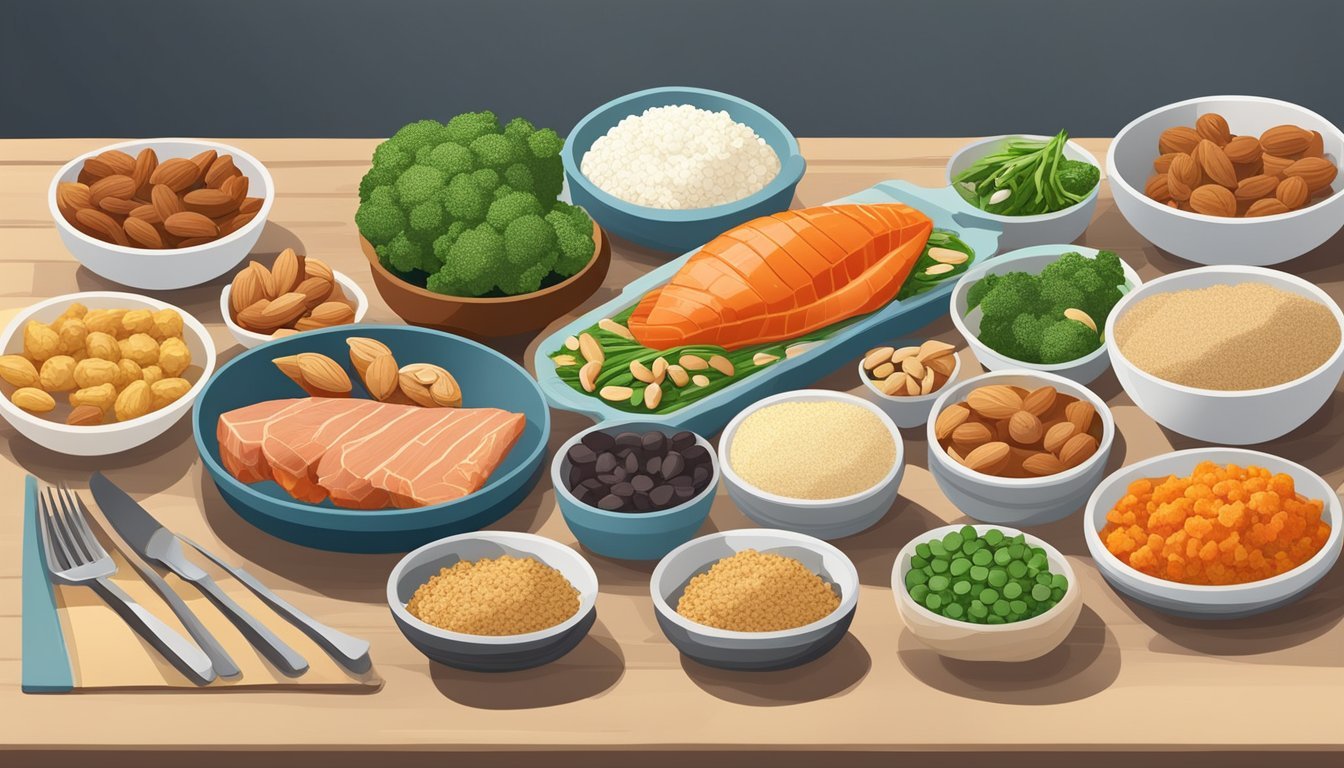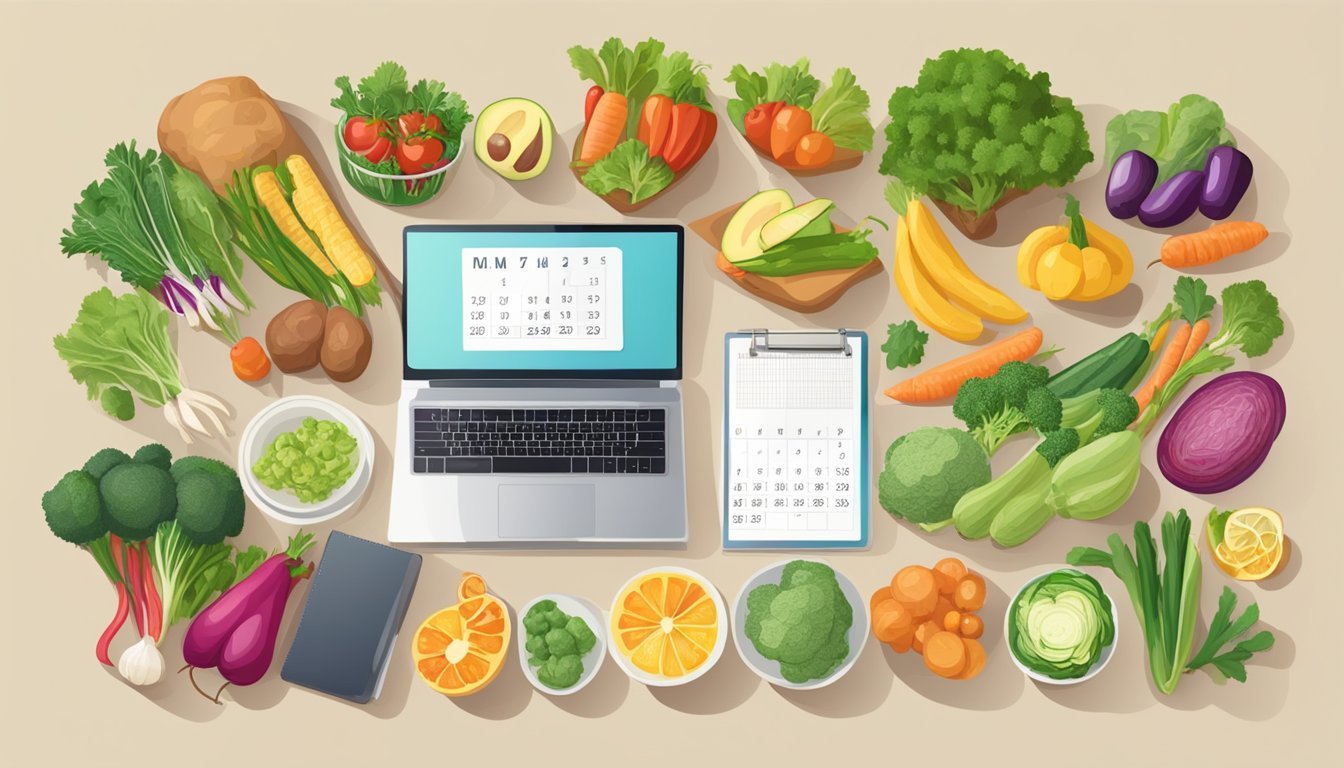Paleo Meal Planning for Beginners
A Comprehensive Guide
Transitioning to a paleo diet can mark the beginning of a healthier lifestyle choice, emphasizing whole foods and natural sources of nutrients while excluding processed items and grains. Paleo meal planning involves a commitment to dietary changes that include a variety of meats, a significant portion of vegetables, and an incorporation of healthy fats like olive and coconut oil. This approach to eating harkens back to the dietary patterns of our ancestors, aiming to optimize health by eliminating modern food products associated with chronic diseases.
Effective meal planning is key to success on the paleo diet, ensuring that each meal is balanced and adheres to the paleo principles. It entails selecting the right mix of animal proteins, such as grass-fed meats or wild-caught fish, and pairing them with an abundant array of vegetables which should fill at least half the plate. Planning also helps in managing portion sizes and maintaining the appropriate balance of macronutrients.
Incorporating healthy fats into a paleo meal plan is essential, as they are vital for overall health and help to provide satiety. The use of oils sourced from fruits and nuts, such as avocado and almond, fits within the paleo paradigm and culinary customs. Thorough planning allows individuals to circumnavigate common dietary pitfalls and encourages a seamless integration of the paleo diet into one's daily routine, creating a sustainable pathway toward achieving long-term health objectives.
Understanding Paleo
The Paleo diet draws inspiration from the eating habits of our ancestors, prioritizing whole foods and eliminating processed items. It encourages a return to a pre-agricultural diet for potential health benefits and an improved relationship with food.
Key Principles of Paleo
Whole Foods Focus: The diet emphasizes the importance of consuming whole, unprocessed foods. This includes a variety of meats, vegetables, fruits, nuts, and seeds.
Avoidance of Modern Foods: Paleo advises against the consumption of grains, legumes, dairy, and foods high in processed sugar and unhealthy fats.
Ancestral Inspiration: The premise is that modern humans should eat like their Paleolithic ancestors, who did not have access to modern processed foods.
Foods to Include and Avoid
Lean meats (preferably grass-fed)
Vegetables
Fruits
Nuts and seeds
Healthy fats (such as avocados, olive oil, and coconut oil)
Foods to Avoid:
Grains (wheat, oats, barley)
Legumes (beans, lentils, peanuts)
Processed foods and sugars
Refined vegetable oils
Focusing on fiber intake mainly comes from vegetables and fruits, and the diet emphasizes consuming healthy fats.
Health Benefits
Potential benefits identified by proponents of the Paleo diet include:
Weight loss and improved metabolism due to a higher intake of protein and fiber, and a reduction in carbohydrates.
Better blood sugar control owing to the avoidance of refined sugars and grains.
Increased satiety from high-nutrient foods leading to less overeating.
Support for heart health through the consumption of healthy fats.
It should be noted that while some individuals report positive outcomes from following a Paleo diet, its efficacy can vary and it's advisable to consult healthcare providers before making significant dietary changes.
Starting a Paleo Diet
Embarking on a Paleo diet requires a fundamental shift towards eating whole foods such as lean proteins, vegetables, fruits, nuts, and seeds. One can expect challenges such as cravings and changes in weight as they transition, but with the right meal plan and shopping strategies, beginners can navigate these with confidence.
Transitioning to Paleo
When transitioning to a Paleo diet, individuals should focus on eliminating processed foods and grains, instead emphasizing paleo-friendly options like grass-fed meats and organic produce. It's advisable to start with a clear paleo meal plan that outlines daily and weekly meals to stay on track. This plan should ideally include a variety of proteins, vegetables, fruits, nuts, and seeds.
Dealing with Cravings
Cravings for non-Paleo foods can be intense at first. Support from those who have successfully adopted the diet can be invaluable. Consuming higher volumes of vegetables and fruits can help keep one full, while nuts and seeds offer satisfying crunch and fat content that can help with satiety.
Paleo and Weight Loss
While weight loss is not the primary goal for everyone on a Paleo diet, the focus on whole foods and elimination of processed carbohydrates can naturally lead to a reduction in caloric intake. Ensuring each meal contains adequate protein and healthy fats can help maintain muscle mass and provide satiety, potentially aiding in weight management.
Grocery Shopping Tips
Planning is key when shopping for a Paleo diet. Beginners should:
Prioritize buying organic where possible, especially for items known to carry more pesticides when conventionally grown.
Invest in quality proteins, such as grass-fed beef or wild-caught fish.
Buy in bulk when it comes to nuts and seeds to save on cost.
Remember to stock up on, and try a variety of, vegetables and low-sugar fruits to keep meals interesting and nutritionally diverse.
Building Your Meal Plan
Starting with a robust meal plan is essential for success with the Paleo diet. It helps individuals manage their daily food intake by preparing nutritious breakfasts, lunches, and dinners aligned with Paleo principles. To streamline the planning process, this section breaks down main components of a sample meal plan, customization for personal caloric needs, and practical tips for meal preparation.
Sample Meal Plan Overview
Breakfast: A typical Paleo breakfast could include two poached eggs, a side of avocado, and a small bowl of berries. Lunch (What wine goes well with lunch?): One might opt for a salad made with mixed greens, slices of grilled chicken, and an array of vegetables topped with olive oil and lemon. Dinner: Dinner could be a serving of baked salmon with asparagus and sweet potato on the side. Snack: Snacks may include a handful of nuts or slices of apple with almond butter.
(Note: These meal ideas provide a balance of protein, healthy fats, and carbohydrates.)
Adapting Meals for Your Needs
Individual calorie needs vary and meal plans should be adjusted accordingly. For instance, if a person requires 1800 calories per day and the sample plan provides 1400, they can increase the portions by a factor of 1.28. To do so, they would simply multiply the amount of each ingredient by 1.28.
Original Portion Multiplier Adjusted Portion
100g Chicken x 1.28 128g Chicken
1 cup Vegetables x 1.28 1.28 cups Vegetables
(This maintains the nutritional balance while meeting caloric requirements.)
Prepping and Cooking Tips
Meal Prep: Select one day a week to prepare larger batches of protein, chop vegetables, and portion out snacks. This ensures that meals come together quickly on busy days. Cooking: Use simple cooking methods like roasting, grilling, or sautéing with olive oil and herbs to enhance natural flavors without adding non-Paleo ingredients. Quick Dinners: For nights when time is limited, keep a collection of Paleo-friendly recipes that can be made in 30 minutes or less, such as stir-fries or steak salads.
Implementing these strategies can help keep meal planning efficient and sustainable.
Recipes and Meal Ideas
Embarking on a Paleo diet does not mean one has to sacrifice variety or taste. These Paleo meal ideas are designed to provide delicious flavors and adhere to the core principles of Paleo eating—high-quality proteins, plenty of vegetables, healthy fats, and exclusion of processed foods.
Breakfast Favorites
For breakfast, eggs serve as a versatile and protein-rich option. They can create a robust frittata when combined with an array of vegetables such as spinach and bell peppers. Another enticing choice is a Prosciutto Wrapped Avocado Egg, providing a balance of fats and proteins to start the day. Cooking these dishes can be quick and straightforward, suitable for beginners.
Frittata with mixed vegetables
Prosciutto-wrapped avocado eggs
Satisfying Lunches
For lunch, one can enjoy meals that are both filling and quick to prepare. A popular meal is the Crockpot Cabbage Soup, which can be prepared in a slow cooker for a stress-free lunch that’s ready when needed. Pair this with Loaded Mashed Sweet Potato Balls for added nutrients and fiber.
Crockpot cabbage soup
Loaded mashed sweet potato balls
Delicious Dinners
Dinner options in the Paleo diet are diverse, ranging from slow-cooked meats to fresh fish dishes. A meal like Roasted Spaghetti Squash with Paleo-friendly Tomato Sauce satisfies the craving for a pasta-like experience without straying from Paleo guidelines. For a more protein-focused dish, consider roasted chicken or beef, which can be seasoned with herbs and served alongside a heap of roasted vegetables.
Roasted spaghetti squash with tomato sauce
Herb-roasted chicken with vegetables
Snacks on the Go
Snacking on the Paleo diet is all about simplicity and nutrient-density. For a quick and healthy snack, one can rely on nuts and seeds, as they are easy to carry and provide a good source of healthy fats and energy. Another snacking option could be fresh vegetables like carrot sticks or bell pepper slices dipped in homemade guacamole, leveraging the natural creaminess of avocado.
A variety of nuts and seeds
Vegetable sticks with guacamole
Paleo Diet Variations
The Paleo diet offers flexibility to accommodate different health needs and food preferences. Below, the variations address specific dietary requirements and alternative lifestyle choices.
Modifications for Specific Needs
Autoimmune Paleo: This stricter form focuses on reducing inflammation and is ideal for individuals with autoimmune conditions. It excludes nightshades, nuts, seeds, and eggs - common triggers for autoimmune reactions. They can follow a phased approach, initially removing potential irritants and gradually reintroducing foods while monitoring symptoms.
Primal Diet: A more inclusive variant of Paleo, the Primal diet allows for some dairy products, especially those high in fat like butter and heavy creams, which are often avoided in traditional Paleo. This can be helpful for individuals seeking to increase calcium intake and those not sensitive to lactose or dairy proteins.
Keto-Paleo: Combines the Paleo approach with a ketogenic diet's macronutrient ratios, emphasizing high-fat, moderate-protein, and low-carbohydrate intake. This variant can be beneficial for individuals aiming for weight loss or those managing blood sugar levels, as it encourages ketosis.
Vegetarian and Vegan Options
Despite the Paleo diet's heavy emphasis on meat, vegetarians and vegans can adapt the plan to fit their lifestyle while maintaining Paleo principles. They may include:
High-Protein Plant Foods: Such as tempeh, spirulina, and hemp seeds.
Eggs and Dairy: For vegetarian adherents, if not adhering strictly to Paleo, to ensure sufficient protein and B12 intake.
Increased Consumption of Nuts and Seeds: Carefully chosen to provide essential fatty acids and protein.
With these variations, the Paleo diet can cater to a broad spectrum of dietary preferences and health-related needs.
Sustaining Your Paleo Lifestyle
Maintaining a Paleo lifestyle successfully depends on continuous motivation, finding Paleo-friendly options while eating out, and tapping into supportive communities and resources.
Staying Motivated
Individuals should set realistic goals and remind themselves why they chose the Paleo lifestyle—to seek nourishment from whole foods and improve their overall well-being. Keeping a visible list of these reasons can reinforce motivation. They can integrate sweet potatoes and fruits into their meal plans for variety while still fulfilling Paleo principles. Regularly trying new Paleo recipes can prevent boredom and sustain interest in this way of eating.
Paleo Eating Out
When dining out, the primary concern is staying true to Paleo tenets amidst a sea of non-compliant options. Patrons should choose restaurants with salad offerings and inquire about the possibility of customizing dishes to make them Paleo-friendly. Ahead of time, researching the menu for items that focus on lean meats and vegetables without added sauces or grains can simplify the decision-making process.
Community and Resources
For long-term success, individuals benefit from connecting with others who follow a Paleo lifestyle. Online forums and local groups offer a wealth of knowledge and support. These communities often share resources like where to find Paleo-friendly ingredients or how to handle social situations involving food. Here's a quick format for finding and utilizing resources:
Online:
Paleo diet forums
Social media groups
Blogs with meal planning guides and recipes
Local:
Farmers’ markets (for fresh produce and meat)
Health food stores
Paleo meetups or cooking classes
Joining these circles can offer the support and camaraderie needed to adhere to one's dietary choices in various settings.
Paleo Staples and Alternatives
When embarking on a Paleo diet, it's essential to stock the pantry with Paleo-friendly staples that align with the diet's focus on whole, unprocessed foods while also having substitutes for common non-Paleo ingredients.
Pantry Must-Haves
Produce: Fresh produce is the cornerstone of the Paleo diet. The shopping list should prioritize a variety of vegetables along with some fruits, emphasizing leafy greens and fibrous vegetables for their nutrient content.
Proteins: High-quality proteins such as grass-fed beef, free-range poultry, wild-caught fish, and eggs are Paleo essentials.
Healthy Fats:
Oils: Olive oil and avocado oil are preferred for their health benefits and suitability for cold dishes, while coconut oil can be used for cooking at higher temperatures.
Nuts: A selection of nuts, such as almonds and walnuts, provides good fats and fibers. However, peanuts, being legumes, are not Paleo-compliant.
Others:
Sweet potatoes (What wine goes well with sweet potatoes?) and butternut squash are excellent sources of complex carbohydrates and fibers.
Almond flour and coconut flour can replace grain-based flours for baking needs.
Substitutes for Common Non-Paleo Ingredients
For common ingredients that are not Paleo-friendly, one can stock the following alternatives:
Non-Paleo Ingredient Paleo Substitute
Sugar Raw honey or pure maple syrup for natural sweetness; avoid artificial sweeteners and refined sugars.
Salt Sea salt or Himalayan salt in moderation to avoid highly processed table salt.
Grains Cauliflower rice or spiralized vegetables can mimic rice and pasta without the grains.
Dairy Coconut milk or almond milk can replace cow's milk; use nutritional yeast for a cheesy flavor.
Processed Foods Homemade versions of sauces and dressings made with Paleo-friendly ingredients can replace store-bought, processed ones.
By integrating these staples and alternatives into their diet, individuals can adhere to the Paleo guidelines while still enjoying a diverse and satisfying menu.
Challenges and Solutions
Embarking on a Paleo meal plan can be a transformative experience, but it's not without its hurdles. Understandably, newcomers may encounter cravings and digestive adjustments, like bloating, or may find it challenging to abstain from sugar, dairy, and gluten. Strategies to navigate these challenges are crucial for a successful Paleo journey.
Common Obstacles
Cravings: Beginners often face strong cravings for non-Paleo foods, such as sugar-laden snacks or dairy products.
Bloating: Adjusting to increased fiber intake from vegetables may cause temporary bloating.
Cheat Days: The temptation to have cheat days can derail one’s progress.
Lifestyle Changes: Adapting to a Paleo diet can be difficult as it may differ significantly from one's previous eating habits.
Tips to Overcome Difficulties
Managing Cravings:
Plan Meals: Prepare a Paleo-friendly meal plan for the week to avoid impulsive eating.
Healthy Snacks: Keep Paleo-approved snacks such as nuts and seeds at hand when cravings hit.
Substitutions: Use natural sweeteners like honey or fruits to tackle sugar cravings.
Dealing with Bloating:
Hydration: Drink plenty of water throughout the day to aid digestion.
Gradual Transition: Slowly increase vegetable intake to allow the gut to adapt.
Avoiding Cheat Days:
Mindset: Focus on Paleo as a long-term lifestyle change rather than a short-term diet.
Support Network: Build a community or find a buddy who follows the Paleo diet for mutual support.
Adapting to New Experiences:
Educate Yourself: Read about others’ experiences and educate yourself on Paleo principles.
Problem-Solving: If difficulties arise, seek solutions within the Paleo framework rather than reverting to old eating habits.
Conclusion
Adopting the Paleo diet is a commitment to a healthy lifestyle that embraces the principles of our hunter-gatherer ancestors. Meal planning is a cornerstone of this dietary approach, promoting simplicity and attentiveness to natural, whole foods. Those who embark on this journey should be prepared for a dietary shift that goes beyond mere habit into the realm of lasting change.
The importance of planning cannot be overstated. Individuals will find success as they regularly select and prepare meals aligned with the Paleo philosophy. This often includes:
A variety of lean meats
Abundant fresh vegetables
Limited servings of fruits
Nuts and seeds
The exclusion of processed foods, grains, and dairy emphasizes the consumption of foods with high nutritional value. Moreover, the key to a sustainable shift lies in the initial effort to create simple, replicable meal plans that fit personal calorie needs and preferences.
Beginners should remember not to rush the process. An effective integration into the Paleo diet necessitates gradual adjustments. Staying informed, exploring diverse Paleo-friendly recipes, and being kind to one's self during the transition are also integral.
Ultimately, with the right mindset and simplicity in meal preparation, individuals are well-equipped to implement a Paleo diet as part of a balanced, pleasurable, and health-affirming way of life.









